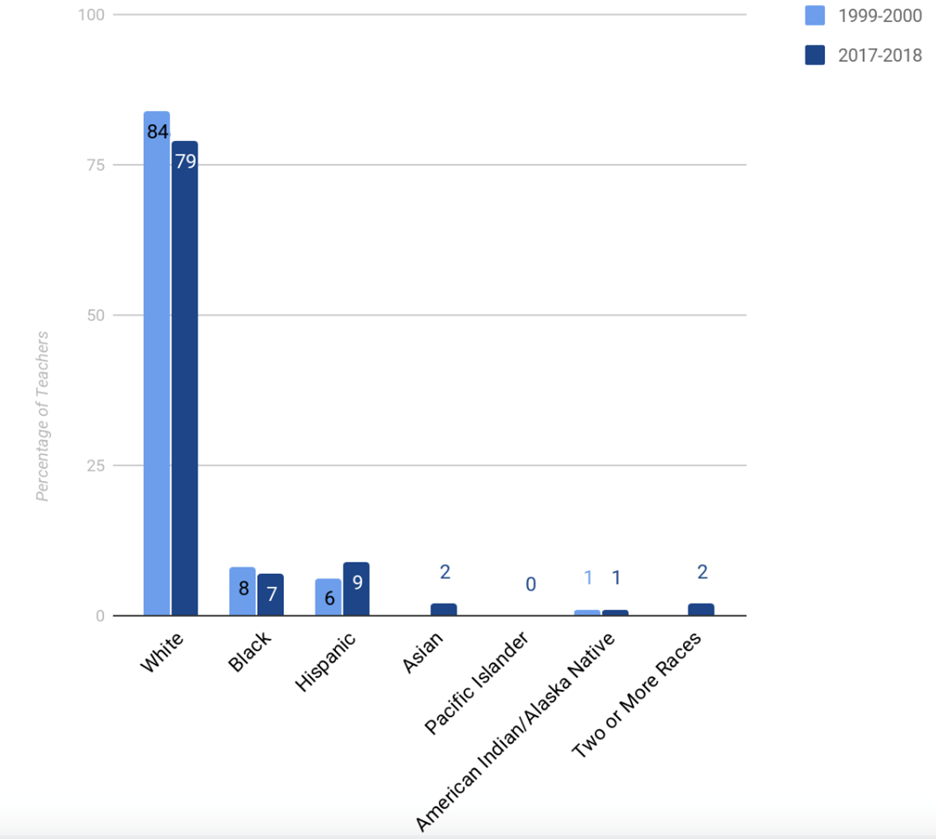Profiles of Teachers Today
 Preparing to Learn
Preparing to Learn
Profiles of Teachers Today
Before discussing the profiles of teachers today, check out the demographics of teachers in your state or school district by visiting the State Report Cards website. How do they compare? Find the salary scales for teachers in your local school district. How do they compare?
Introduction
Unsurprisingly, public education spaces struggle to hire teachers and administrators who adequately represent the students being served. This chapter explores the profiles of teachers today by looking at the demographics of teachers and students alike. With this, it presents inequities in context that continue to surface for non-White educators and highlights the importance of diversity in educational spaces.
Profile Of Teachers Today[1]
The National Center for Educational Statistics (NCES) collects data on various aspects of education, including the demographics of teachers and students. In the 2017-2018 school year, there were 3.5 million full- or part-time public-school K-12 teachers (NCES, 2020a). (K-12 means the range of grades public schools serve, starting with kindergarten in elementary school and culminating with 12th grade in high school.) Of those teachers, 76% were female[1], 79% were White, 90% held a standard teaching license (more on that below), and 58% had earned a graduate degree (at the master’s level or beyond). Many teachers were in the middle of their careers, with 40% having ten to twenty years of experience in the classroom. The average salary of a full-time public school teacher was $57,900, with the average first-year teacher earning $44,200. (Note that salaries vary based on years of experience, highest degree earned, and location.)
Let’s revisit some of those demographics related to racial diversity. The graph below depicts specific racial categories of public school teachers in the 2017-2018 school year, compared with the 1999-2000 school year.
Racial Demographics of U.S. Public School Teachers, 1999-2000 and 2017-2018
 The trends are clear: in the United States, we lack a racially diverse teaching force, and that trend has not changed much in the past 20 years. While the 2017-2018 school year included more Hispanic, Asian, and multi-racial teachers, teachers are still overwhelmingly White. However, in the same school year, students who attended public schools were only 44% White (NCES, 2020b). That means there are generally more White teachers and more students of color (Geiger, 2018). This trend is concerning, given that research shows that having teachers of color benefits all students, not just students of color.
The trends are clear: in the United States, we lack a racially diverse teaching force, and that trend has not changed much in the past 20 years. While the 2017-2018 school year included more Hispanic, Asian, and multi-racial teachers, teachers are still overwhelmingly White. However, in the same school year, students who attended public schools were only 44% White (NCES, 2020b). That means there are generally more White teachers and more students of color (Geiger, 2018). This trend is concerning, given that research shows that having teachers of color benefits all students, not just students of color.
There are many reasons why teachers in the United States are not racially diverse. While the U.S. Supreme Court’s 1954 decision in Brown v. Board of Education demanded all schools integrate to address some of the inequalities between separate schools for White and Black students, it did have other consequences that directly impacted the diversity of teachers in the United States. This case caused 38,000 Black teachers (about one-third of the Black teachers in the country) to lose their jobs in the years following the case (Milner & Howard, 2004; Thompson, 2019). Even though this historical antecedent did limit access to teaching jobs for Black people, racial discrimination in the hiring process continues to compound this issue. D’Amico et al. (2017) found that despite equally-qualified candidates applying for jobs in one large school district, White teacher candidates still received a disproportionate number of job offers: of the 70% White applicants, 77% received job offers, while of the 13% Black candidates, 6% received job offers (D’Amico, Pawlewicz, Earley, & McGeehan, 2017; Klein, 2017). Beyond the hiring process, retention of hired teachers is lower for teachers of color than for White teachers. For example, between the 2011-2012 and 2012-2013 school years, only 15% of White teachers left their jobs, compared to 22% of Black teachers and 21% of Hispanic teachers (U.S. Department of Education, 2016).
 Critical Perspective
Critical Perspective
Social Justice Education
There are many reasons why teachers in the United States are not racially diverse. While the U.S. Supreme Court’s 1954 decision in Brown v. Board of Education demanded all schools integrate to address some of the inequalities between separate schools for White and Black students, it did have other consequences that directly impacted the diversity of teachers in the United States. This case caused 38,000 Black teachers (about one-third of the Black teachers in the country) to lose their jobs in the years following the case (Milner & Howard, 2004; Thompson, 2019). Even though this historical antecedent did limit access to teaching jobs for Black people, racial discrimination in the hiring process continues to compound this issue. D’Amico et al. (2017) found that despite equally-qualified candidates applying for jobs in one large school district, White teacher candidates still received a disproportionate number of job offers: of the 70% White applicants, 77% received job offers, while of the 13% Black candidates, 6% received job offers (D’Amico, Pawlewicz, Earley, & McGeehan, 2017; Klein, 2017). Beyond the hiring process, retention of hired teachers is lower for teachers of color than for White teachers. For example, between the 2011-2012 and 2012-2013 school years, only 15% of White teachers left their jobs, compared to 22% of Black teachers and 21% of Hispanic teachers (U.S. Department of Education, 2016).
 Knowledge Check
Knowledge Check
Profile of Teachers Today
Now that you have had an opportunity to read about the profile of teachers today, revisit the State Report Cards website to check out the demographics of teachers in your state or school district. Now that you have a deeper understanding of the profile of teachers, what are your thoughts on the demographic and salary scales? Why do you think this is?
References
- The following chapter is revised from Introduction to Education by Angela Hooser and Janna McClain, under a Creative Commons Attribution-NonCommercial-ShareAlike 4.0 International License ↵
